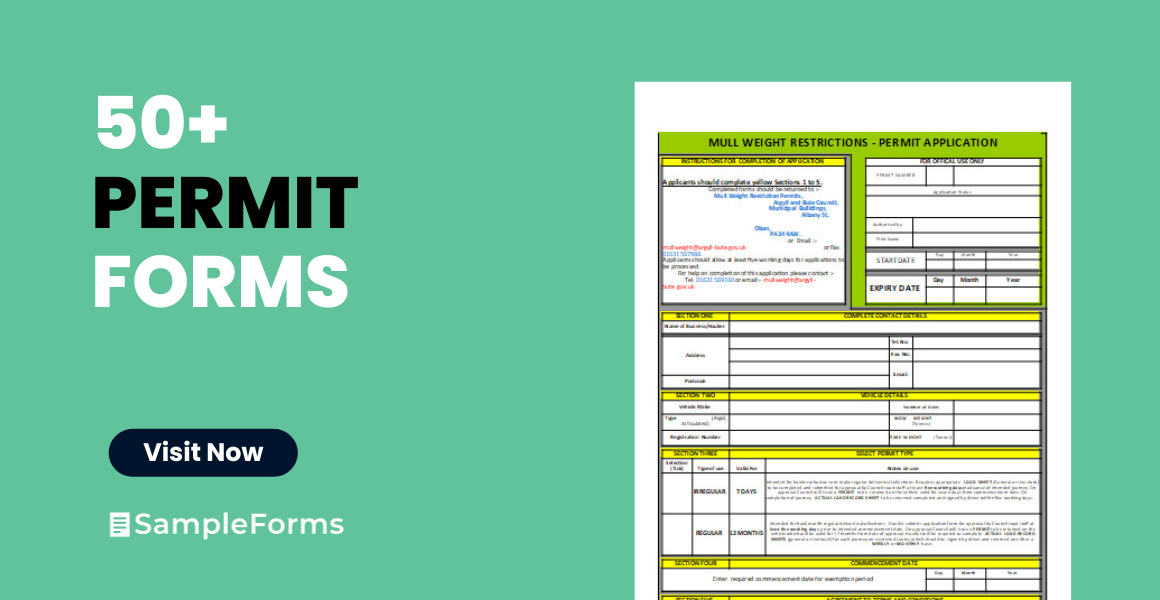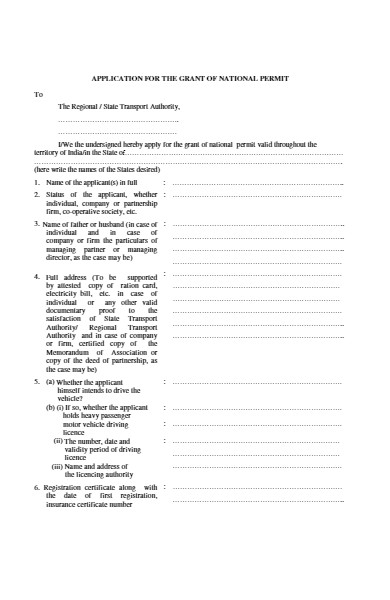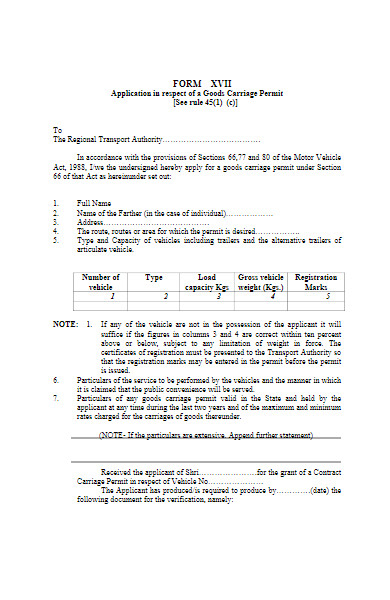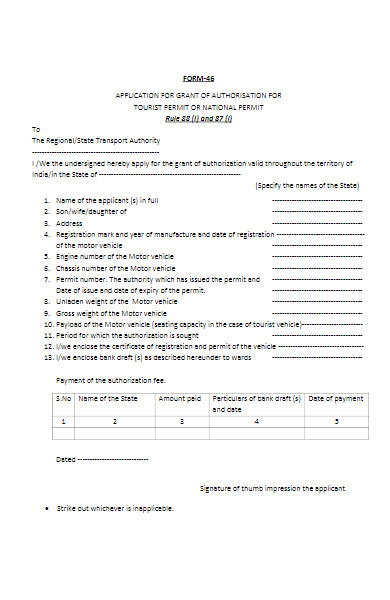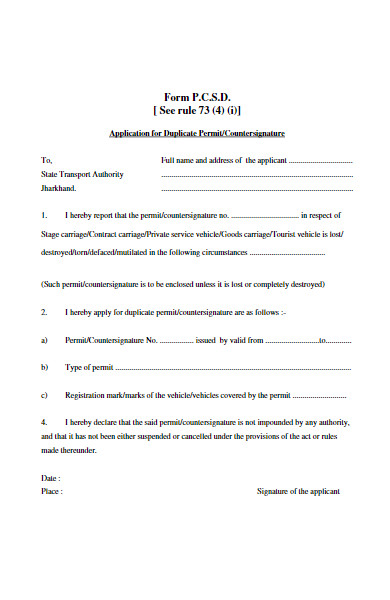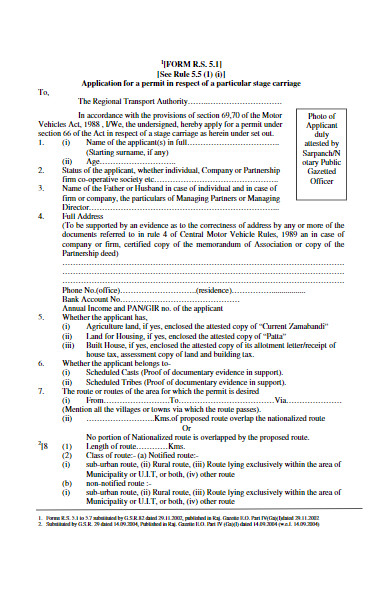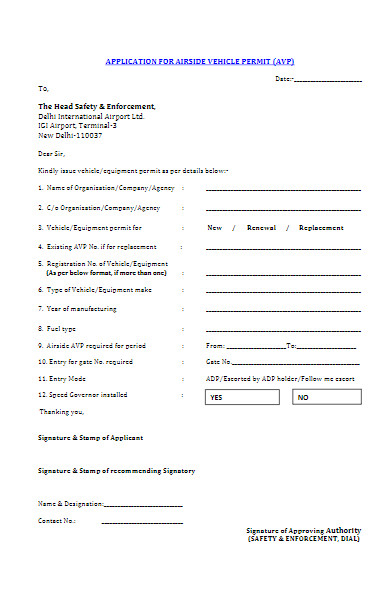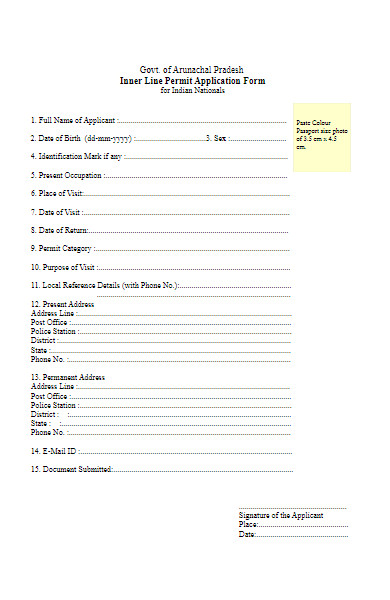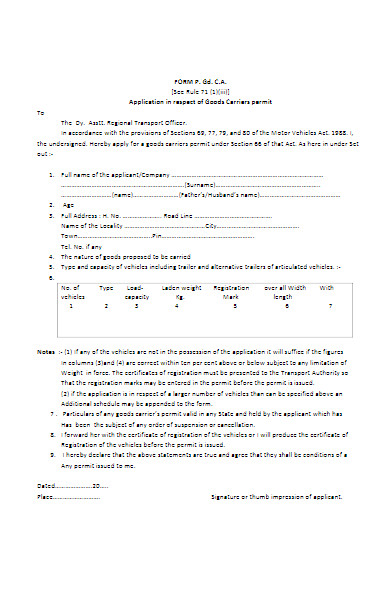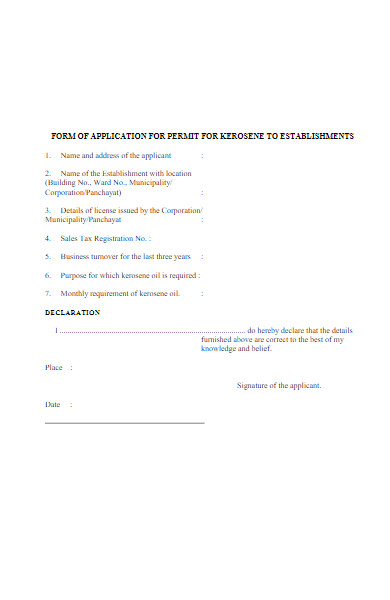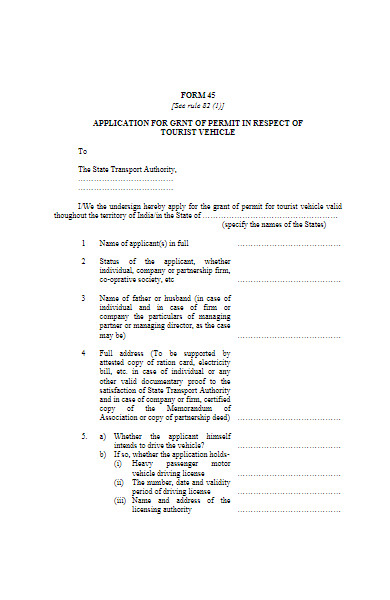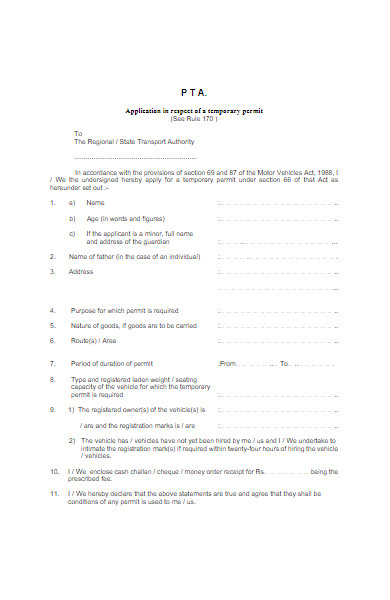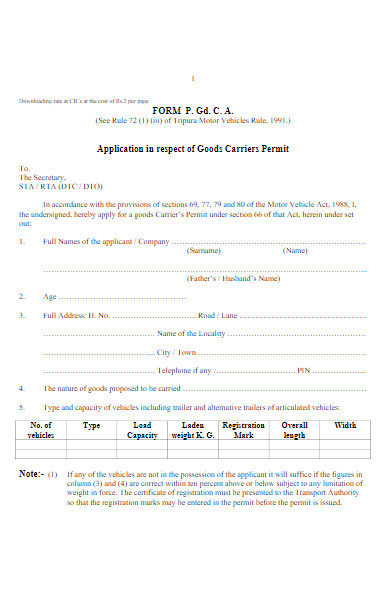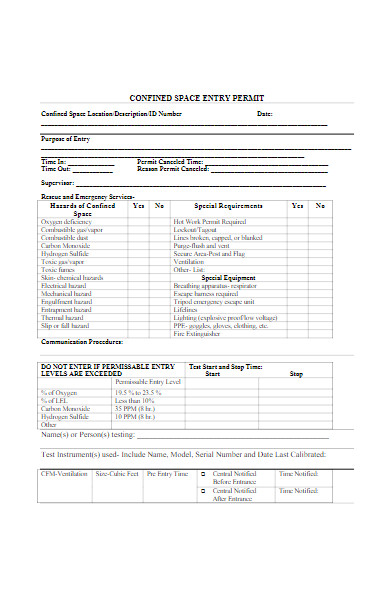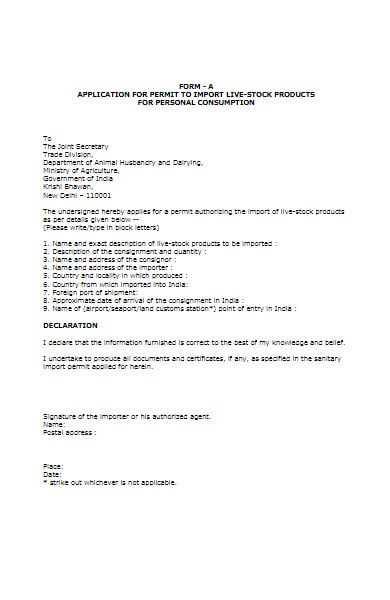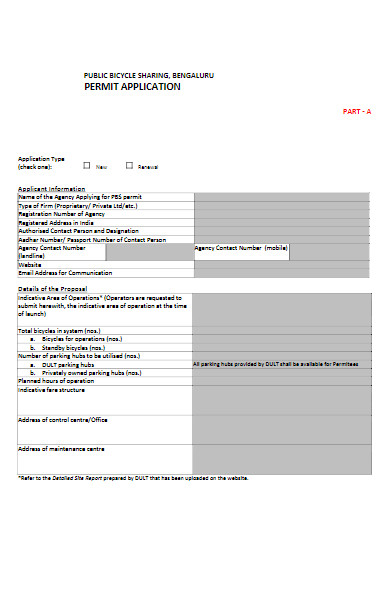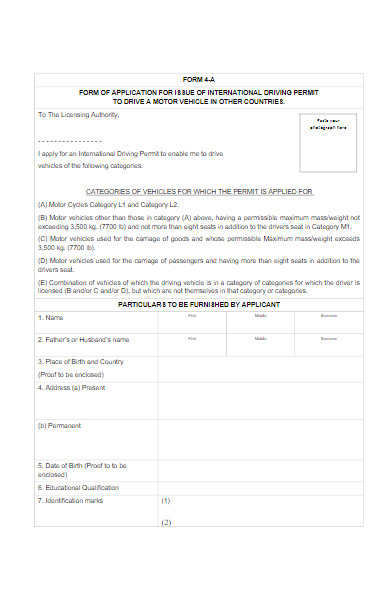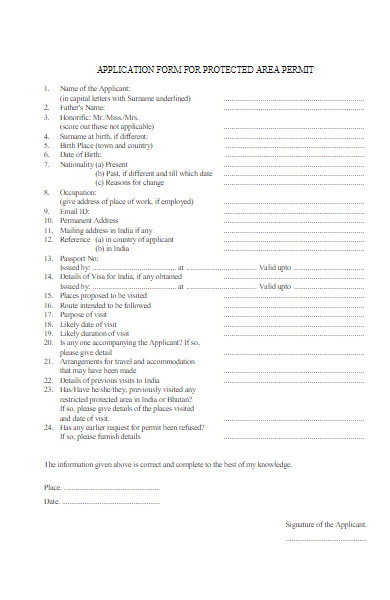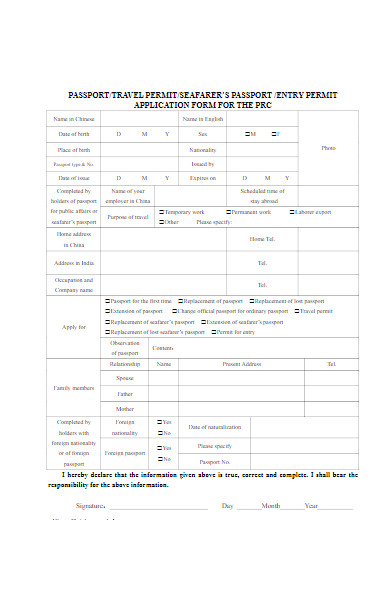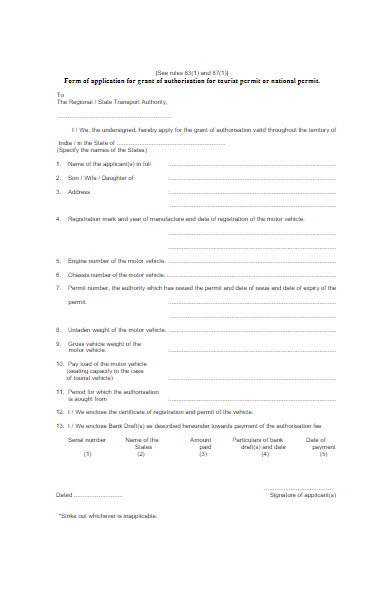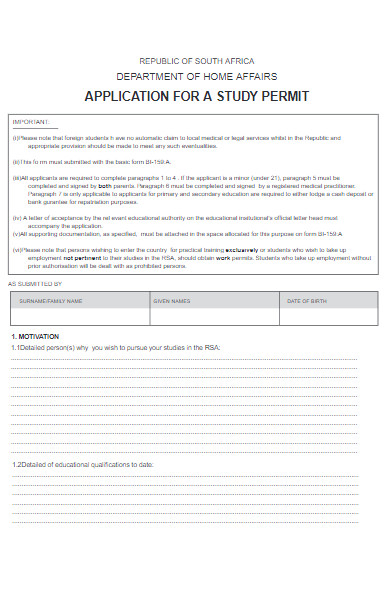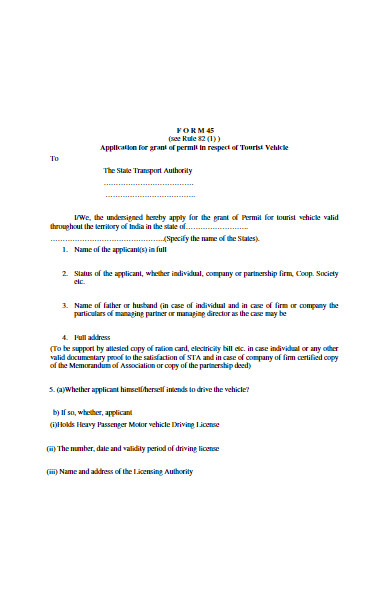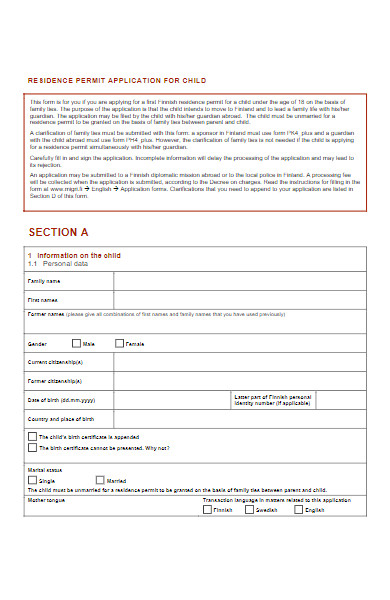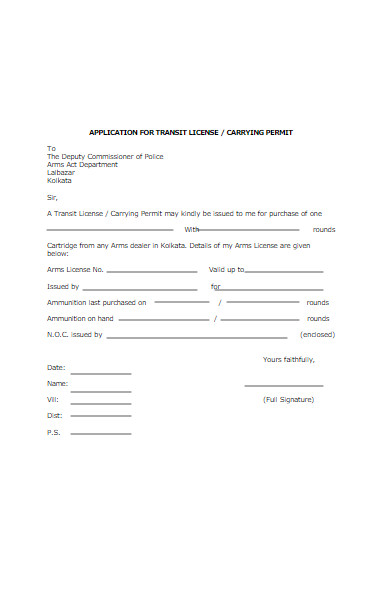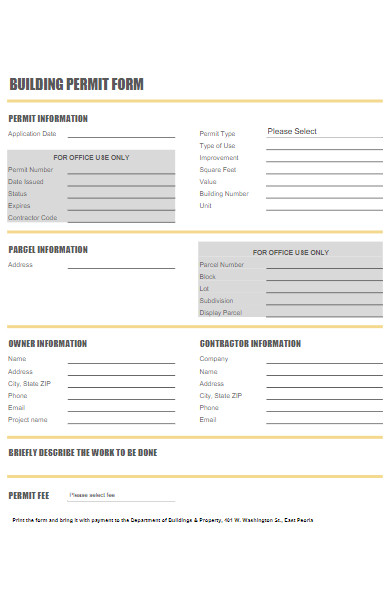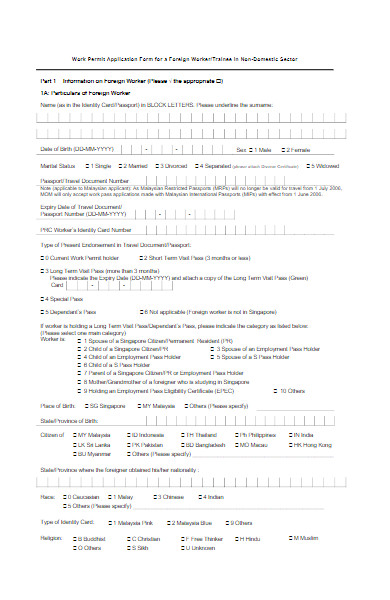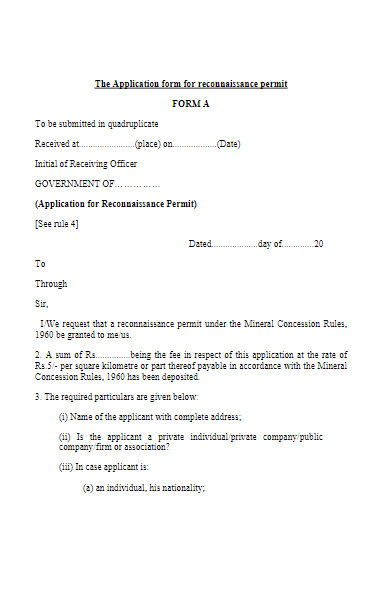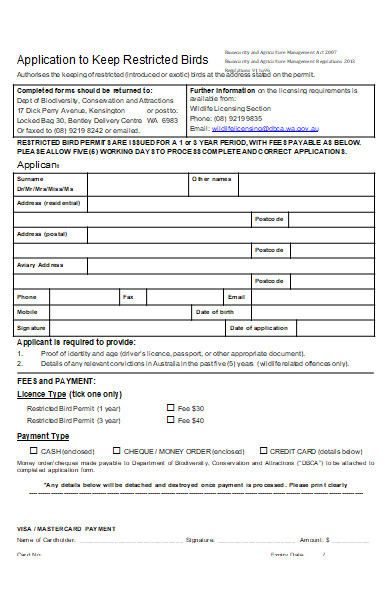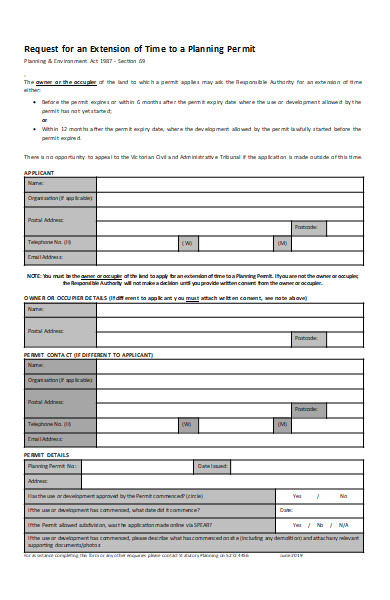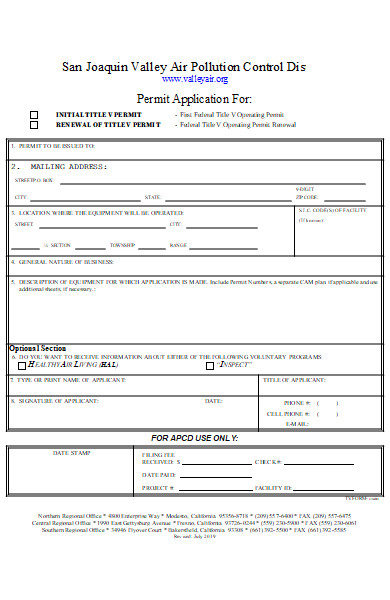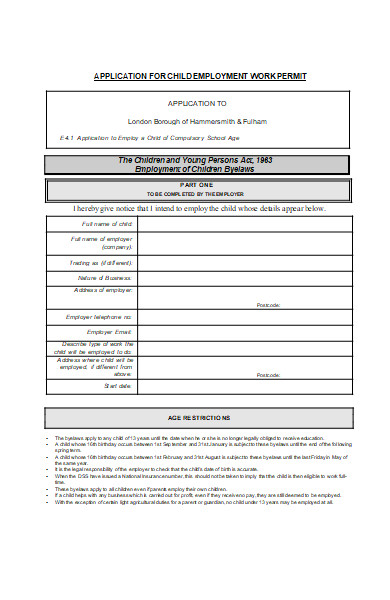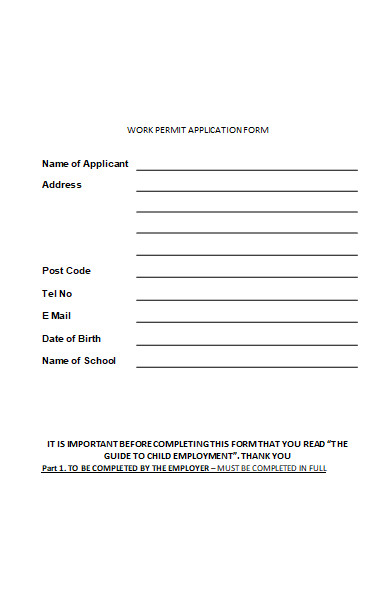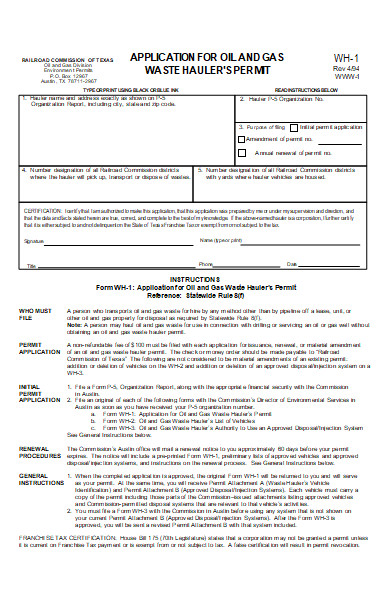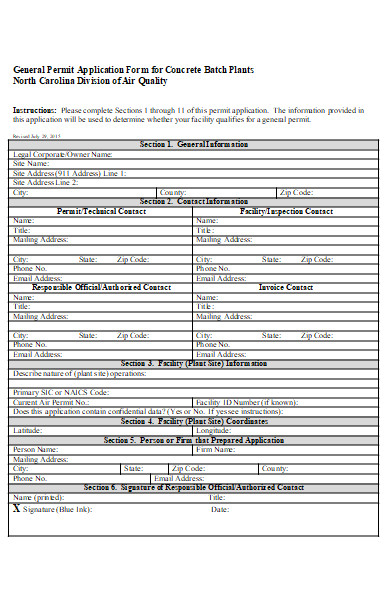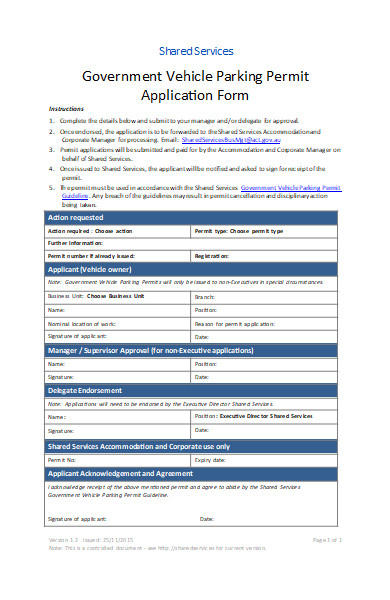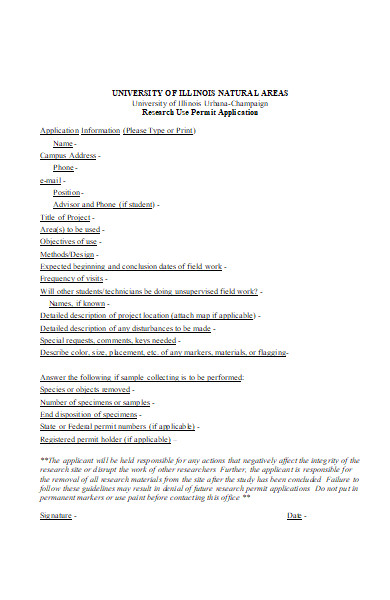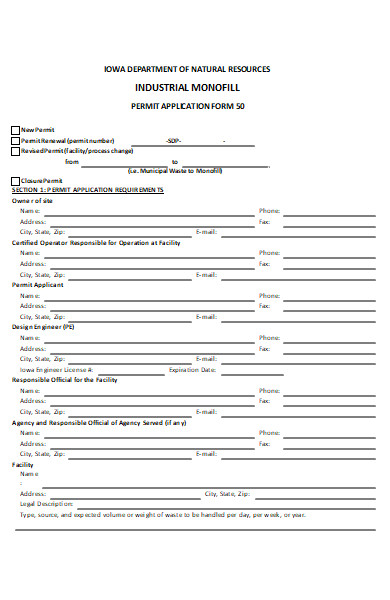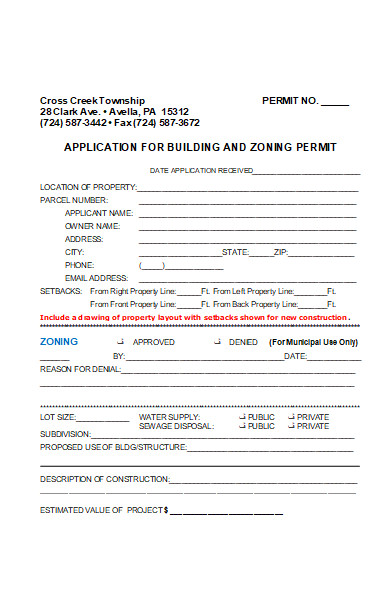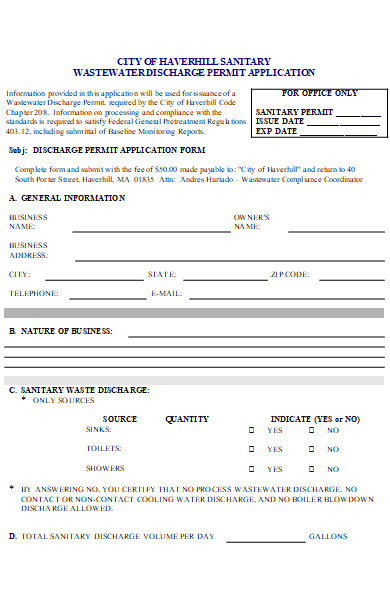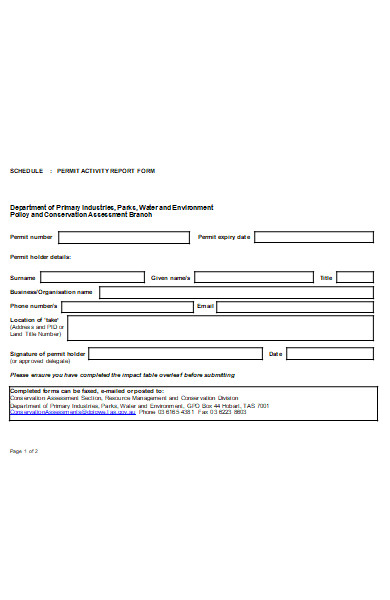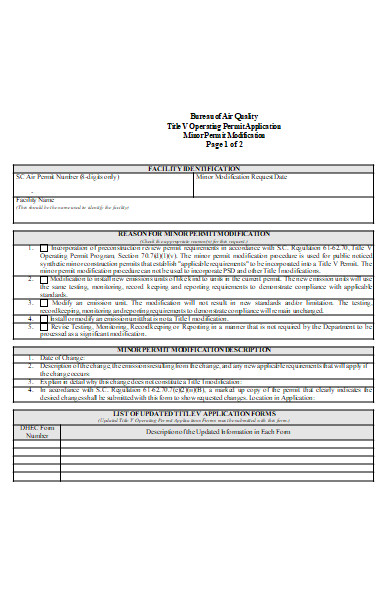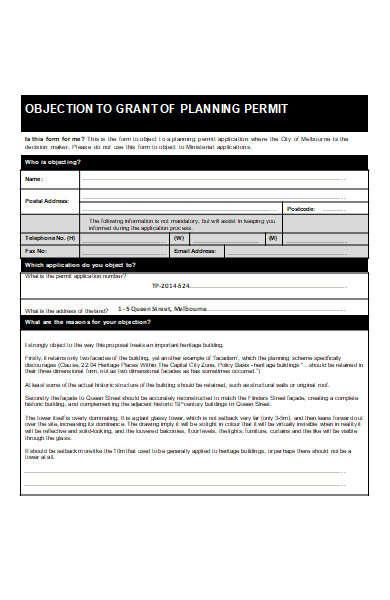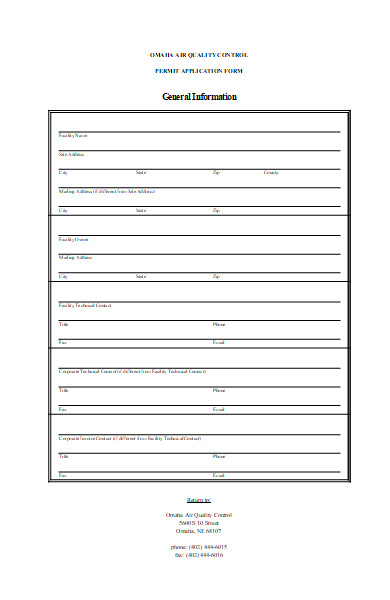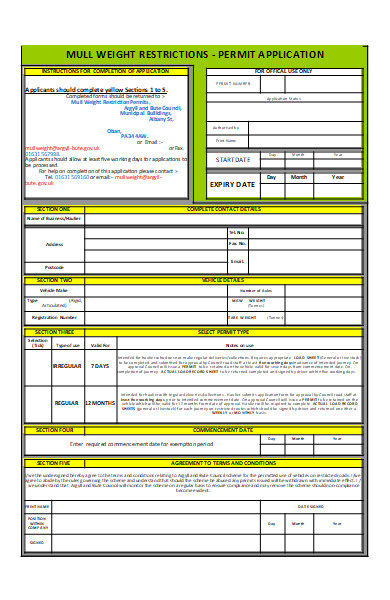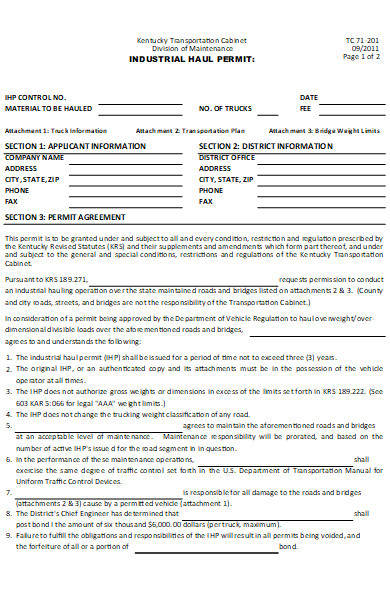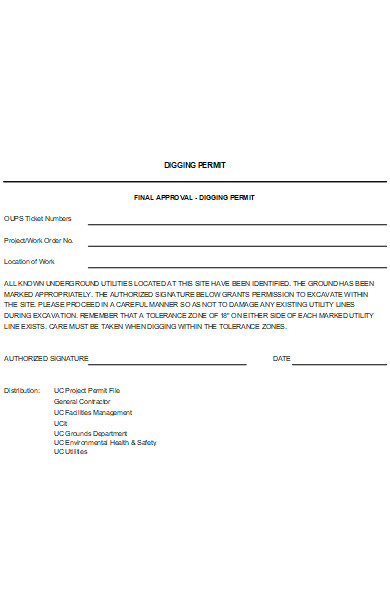These essential documents are your gateway to a wide range of activities, from construction projects to events and beyond. In this comprehensive guide, we’ll explore the meaning and significance of Permit Forms, delve into various types, provide real-world fillable forms examples, offer expert tips, and walk you through the process of creating your very own. Get ready to navigate the permit landscape with confidence and efficiency.
What is a Permit Form ? – Definition
A Permit Form, in essence, is a standardized document or application that individuals or entities use to obtain official permission or authorization from relevant authorities. These printable forms play a crucial role in ensuring that various activities, such as construction, events, or specific services, comply with established regulations and safety standards. By submitting a Permit Form, applicants seek approval to proceed with their intended projects or actions while adhering to legal and safety requirements.
What is the Meaning of a Permit Form?
The meaning of a Permit Form lies in its role as a formal document that individuals or organizations must submit to gain official consent or authorization for specific activities or projects. These Blank forms serve as a bridge between applicants and regulatory authorities, ensuring that proposed actions comply with legal and safety regulations. Permit Forms are a means to maintain order, safety, and compliance within various domains, including construction, events, and services, by facilitating the approval process for specific endeavors.
What is the Best Sample Permit Form?
Here are the steps to create the best sample Permit Form:
Step 1: Define the Purpose
- Clearly define the purpose of the Permit Form, specifying the type of activity or project it will be used for.
Step 2: Identify Required Information
- Determine the essential information applicants must provide, such as project details, contact information, and specific requirements.
Step 3: Design the Form
- Create a user-friendly layout, dividing the form into sections with clear headings.
Step 4: Fields and Labels
- Add fields and labels for each piece of required information, using plain and concise language.
Step 5: Instructions
- Include clear instructions that guide applicants on how to complete the form correctly.
Step 6: Validation Rules
- Implement validation rules to ensure data accuracy and completion.
Step 7: Declaration and Signature
- Include a section for applicants to declare the accuracy of the information and provide a signature.
Step 8: Formatting and Branding
- Use consistent formatting and incorporate branding elements for a professional appearance.
Step 9: Legal Compliance
- Ensure that the form complies with relevant legal regulations and data protection requirements.
Step 10: Review and Testing
- Review the form for errors, clarity, and completeness, and test it to identify any issues or confusing sections.
By following these steps, you can create a sample Permit Form that is well-structured, user-friendly, and complies with legal and regulatory standards. You also browse our Permit application forms.
FREE 50+ Permit Forms
51. Facility Permit Application Form
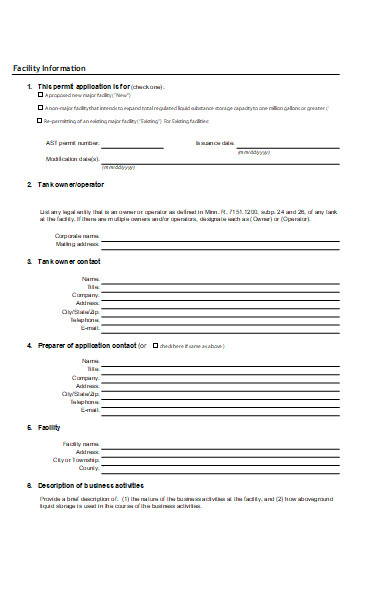
What is the purpose of the permit form, and why do I need to fill it out?
The purpose of a permit form is to obtain official authorization or permission for a specific activity, action, or event. Permit forms serve as a formal means for individuals, businesses, or organizations to request and receive approval from relevant authorities, such as government agencies or local authorities, to carry out activities that might otherwise be restricted or regulated.
You need to fill out a permit form for several reasons:
- Legal Compliance: Many activities, like construction, event planning, or certain business operations, are subject to local, state, or federal regulations. Filling out a permit form ensures that you are complying with these legal requirements.
- Public Safety: Permit forms often include safety and environmental considerations. Filling one out helps ensure that your activity is conducted safely and does not pose risks to the public or the environment.
- Resource Allocation: Some permits are necessary to allocate limited resources, such as parking spaces or land use, fairly among applicants.
- Accountability: Permit forms establish a record of who is responsible for the activity, making it easier to address issues or liabilities if they arise.
In summary, filling out a permit form is essential to ensure that your intended activity or project is legal, safe, and complies with applicable regulations and standards. It helps you obtain official permission and demonstrates your commitment to responsible and lawful conduct. You should also take a look at our Permission Forms.
Where can I find the official permit form for specific type of permit?
To find the official permit form for a specific type of permit, you can typically follow these steps:
- Government Website: Visit the official website of the government authority that oversees the type of permit you need. This might be a city, county, state, or federal government website.
- Search Function: Look for a search function on the website. This is often a search bar at the top of the page. Type in keywords related to the permit you’re seeking, such as “building permit,” “event permit,” or “business license.”
- Permit Section: Check the website’s dedicated section for permits and licenses. Many government websites have a section that provides information and links to various permit applications.
- Department Contacts: If you’re having trouble finding the form, look for contact information for the relevant department or agency. You can usually find a phone number or email address. Contact them and request the specific permit form you need.
- Online Forms: Some government websites have a section where you can directly download permit forms. Look for links or buttons that say “Download Permit Application” or something similar.
- Local Offices: If you can’t find the form online, consider visiting a local government office in person. They can provide you with the necessary forms and guidance on the application process.
- Third-Party Services: In some cases, there are third-party websites or services that can assist you in obtaining permit forms. However, always make sure you are using a reputable source and that the form is official and up-to-date.
It’s important to make sure you are using the official and most current permit form, as requirements and regulations can change over time. Additionally, be sure to read any instructions provided with the form to complete it accurately. Our Work Application Form is also worth a look at
What are the eligibility requirements for obtaining a specific type of permit?
The eligibility requirements for obtaining a specific type of permit can vary widely depending on the nature of the permit and the regulations set by the relevant authority. To determine the eligibility requirements for a particular permit, you should typically:
- Visit the Official Website: Go to the official website of the government agency or authority responsible for issuing the permit. Look for a section related to the specific type of permit you’re interested in.
- Review Documentation: Check if the website provides documentation or information about the eligibility requirements for that permit. This may include guidelines, brochures, or fact sheets.
- Contact the Issuing Authority: If the information is not readily available online, consider reaching out to the issuing authority directly. They can provide you with detailed information on the eligibility criteria.
- Consult Legal or Industry Experts: In some cases, you may want to consult legal or industry experts who are knowledgeable about the specific permit type. They can provide guidance on eligibility based on your unique situation.
- Read Relevant Laws and Regulations: In many cases, eligibility requirements for permits are based on existing laws and regulations. You may need to review these legal texts to fully understand the criteria.
- Attend Workshops or Information Sessions: Some authorities conduct workshops or information sessions to help applicants understand the requirements for specific permits. Attending these sessions can be beneficial.
Remember that the eligibility requirements can differ significantly from one permit type to another. Common eligibility factors might include age, residency, qualifications, business status, compliance with zoning laws, and more. Always ensure that you meet the specific requirements before applying for a permit to avoid potential issues or delays in the application process. In addition, you should review our Work Forms.
Can I check the status of my permit application online?
Yes, in many cases, you can check the status of your permit application online. To do so, you can follow these general steps:
- Visit the Permitting Authority’s Website: Go to the official website of the government agency or authority that you submitted your permit application to.
- Log into Your Account: If you created an online account when you submitted your application, log in using your username and password. This is usually required for tracking your application status.
- Search for Application Status: Look for a section on the website that is dedicated to checking the status of permit applications. This might be labeled as Check Application Status, Track Your Permit, or something similar.
- Provide Required Information: You’ll typically need to enter specific information related to your permit application, such as the application number, your name, and contact details. Make sure you have this information on hand.
- Submit the Request: After entering the required information, submit your request to check the status of your application.
- View the Status: The website should then provide you with the current status of your permit application. This status might include whether your application is pending, approved, denied, or if further action is required.
- Contact the Authority: If you cannot find an online status-checking feature on the website or if you encounter any issues, you can contact the permitting authority directly through the contact information provided on their website.
Please note that the process may vary depending on the specific government agency and the technology they use. It’s important to follow the instructions provided on the agency’s website to check the status of your permit application accurately. This online service is a convenient way to keep track of the progress of your application without the need for phone calls or in-person visits. You may also be interested in our Commercial Property Application Forms.
What supporting documents or information should I include with the permit form?
When filling out a permit form, it’s crucial to include the necessary supporting documents and information to ensure a smooth and successful application process. The specific requirements can vary based on the type of permit you’re applying for and the relevant authority. Here are some common supporting documents and information that may be required:
- Application Form: Start with the completed permit application form, ensuring that you’ve provided all requested information accurately.
- Identification: Personal identification, such as a driver’s license or passport, is often required to confirm your identity.
- Proof of Ownership or Authorization: If the permit is related to a property, you may need to provide documents proving ownership or authorization from the property owner.
- Site Plans or Drawings: For permits related to construction or development, you might need to submit detailed site plans or architectural drawings.
- Legal Descriptions: Include legal descriptions of the property or location where the permitted activity will take place.
- Insurance Documentation: Some permits, particularly for events or businesses, may require proof of liability insurance.
- Financial Documentation: If there are fees associated with the permit, include payment or proof of payment.
- Environmental Impact Statements: In some cases, you may need to provide environmental impact statements or assessments.
- Health and Safety Plans: For permits involving public safety, health, or sanitation, you might need to submit health and safety plans.
- Licenses and Certifications: Include copies of any relevant licenses or certifications required for the activity.
- Photographs: Depending on the type of permit, photographs of the site or existing conditions may be necessary.
- Notarization: Some permits require notarized documents or signatures for added authentication.
- References: For certain permits, you may need to provide references, such as letters of recommendation or character references.
- Other Supporting Documents: The permitting authority may specify additional documents needed for your specific permit application. Always check their guidelines.
- Application Fee: Ensure you include the required application fee. Be prepared to pay by check, credit card, or another acceptable payment method.
It’s essential to carefully review the permit application instructions and guidelines provided by the relevant authority to determine exactly what documents and information are needed for your specific permit. Providing all the required supporting materials ensures your application is complete and can expedite the review and approval process.
How do I go about filling out a permit form correctly?
Filling out a permit form correctly is essential to ensure your application is processed smoothly and efficiently. Here are step-by-step instructions on how to complete a permit form accurately:
- Read the Instructions: Start by thoroughly reading any instructions provided with the permit form. This will give you an overview of the process and requirements.
- Use Legible Handwriting: If the form is to be filled out by hand, use clear and legible handwriting. If possible, consider typing the information to avoid errors.
- Complete All Required Fields: Ensure that you fill in all mandatory fields on the form. These are typically marked with an asterisk (*) or other indicators.
- Follow Formatting Guidelines: If the form has specific formatting requirements, such as date formats or capitalization, make sure to adhere to them.
- Provide Accurate Information: Double-check the accuracy of the information you’re entering. This includes your name, contact details, and any other required data.
- Attach Supporting Documents: Include all the necessary supporting documents, such as identification, site plans, or financial records, as specified in the form’s instructions.
- Use Black or Blue Ink: If filling out a paper form, use black or blue ink to ensure readability.
- Date and Sign the Form: Sign and date the form as required. Some forms may need to be notarized, so follow the instructions carefully.
- Review for Errors: Before submitting the form, carefully review it for errors or omissions. Check for spelling mistakes, missing information, or inaccuracies.
- Photocopy Your Completed Form: Make a photocopy of the completed form for your records before submitting it. This can be useful in case you need to reference the information later.
- Submit the Form: Follow the submission instructions provided with the form. This may involve mailing it, delivering it in person, or submitting it online, depending on the process outlined in the instructions.
- Keep a Record: Keep a record of the date and method of submission. If you’re submitting the form in person or online, you may receive a receipt or confirmation.
- Follow Up: If there is a specified processing time, wait for the outcome. If you don’t receive a response within the expected timeframe, consider following up with the permitting authority to check on the status of your application.
- Comply with Requests for Additional Information: If the permitting authority requests additional information or documentation, provide it promptly to avoid delays in the processing of your permit application.
It’s important to remember that different types of permits may have unique requirements, so always refer to the specific instructions provided with the form to ensure compliance. Accurate and complete information on the permit form will increase your chances of obtaining the permit you need.
Where can I obtain the necessary permit forms?
To obtain the necessary permit forms, you have several options:
- Government Websites: Many government agencies and local authorities provide permit forms on their official websites. Start by visiting the website of the relevant government authority responsible for issuing the permit you need. Look for a “Permits” or “Licenses” section on their website. They often provide downloadable forms in PDF or other formats.
- Online Permitting Portals: Some government agencies offer online permitting portals where you can find and complete permit forms digitally. These portals may guide you through the application process and allow for online submission.
- Local Government Offices: In some cases, you may need to visit your local government office in person. Municipal or county offices often have printed permit forms available at their offices. You can request the specific permit form you need from the office staff.
- Public Libraries: Some public libraries maintain copies of common permit forms. You can check with your local library to see if they have permit forms available or can help you find the forms you need.
- Community Centers: Community centers or city halls may also provide access to permit forms. Inquire with your local community center or city hall for information on obtaining the necessary forms.
- Request by Mail: If the government agency allows it, you can request permit forms to be mailed to you. Contact the relevant authority and request the specific permit form you need to be sent to your mailing address.
- Third-Party Services: There are online services and third-party websites that may offer access to permit forms for a fee. However, it’s essential to ensure that you are using a reputable source and that the form you obtain is official and up-to-date.
When obtaining permit forms, make sure that you are using the most current version, as regulations and requirements may change over time. Always verify the authenticity of the form and its source, especially if you’re obtaining it from a third-party service. Using the official permit forms provided by government agencies is the safest and most reliable approach.
What information and documents are typically required when filling out a permit form?
When filling out a permit form, the specific information and documents required can vary depending on the type of permit you’re applying for and the relevant government authority. However, there are common elements that are typically requested on permit forms. Here’s a list of information and documents that are often required:
1. Personal Information:
- Full legal name
- Contact information (address, phone number, email)
- Date of birth
- Social security number or tax identification number
2. Business Information (if applicable):
- Business name and structure (e.g., sole proprietorship, LLC, corporation)
- Employer identification number (EIN)
- Business address and contact information
3. Property Details (if applicable):
- Property address or location
- Legal description of the property
- Property owner’s information
4. Permit Type and Purpose:
- Specify the type of permit you are applying for (e.g., building permit, event permit, business license).
- Provide details about the purpose of the permit (e.g., construction project, event details).
5. Site Plans or Drawings (if applicable):
- Detailed site plans, architectural drawings, or diagrams for construction or development permits.
6. Identification and Proof of Eligibility:
- Driver’s license, passport, or other identification documents.
- Proof of eligibility, such as proof of ownership or authorization for the proposed activity.
7. Insurance Documents (if applicable):
- Proof of liability insurance for permits related to events, businesses, or certain activities.
8. Financial Documentation (if applicable):
- Payment for the application fee.
- Financial records, budgets, or financial statements for business-related permits.
9. Environmental Impact Statements (if applicable):
- Environmental impact assessments or statements for permits involving potential environmental effects.
- Plans related to public safety, health, or sanitation, depending on the type of permit.
11. References (if applicable):
- Letters of recommendation, character references, or other references required for certain permits.
12. Licenses and Certifications (if applicable):
- Copies of relevant licenses or certifications necessary for the activity or business.
13. Notarization (if applicable):
- Some permits require notarized documents or signatures for added authentication.
14. Other Supporting Documents:
- Any other specific documents or information requested by the permitting authority in the instructions.
It’s essential to carefully read and follow the instructions provided with the permit form, as they will specify the exact information and documents required for your specific permit application. Providing complete and accurate information and documents is crucial to the success of your application and to expedite the review process.
How to Create a Permit Form? – a Step by Step Guide
Creating a permit form is a process that involves careful planning and attention to detail to ensure that the form collects all necessary information efficiently. Here’s a step-by-step guide on how to create a permit form:
Step 1: Determine the Type of Permit Form
Identify the specific type of permit for which you are creating the form. This will help you tailor the form to collect the relevant information. For example, it could be a building permit, event permit, or business license application.
Step 2: Define the Purpose and Scope
Clearly define the purpose and scope of the permit form. What is the permit for, and what information do you need from applicants? Consider the specific requirements and regulations associated with the permit.
Step 3: Research and Legal Compliance
Research the legal requirements, regulations, and standards related to the permit. Ensure that your form aligns with all necessary legal and regulatory requirements. Consult with relevant authorities or legal experts if needed.
Step 4: Choose a Format
Decide on the format of the permit form. You can create a paper form for manual submission, a digital form for online submission, or both. Digital forms are often more convenient for applicants.
Step 5: Design the Form
Design the form with a clean and organized layout. Include clear headings, sections, and fields for capturing information. Consider using user-friendly elements like drop-down menus, radio buttons, and checkboxes.
Step 6: Collect Applicant Information
Include fields to collect personal information, such as name, contact details, and, if necessary, identification details like a driver’s license number.
Step 7: Specify Permit Details
Clearly outline the permit type and its purpose. Provide detailed instructions or guidance on what the applicant should provide and why.
Step 8: Request Supporting Documents
Identify any supporting documents required for the permit application and create fields or upload sections for applicants to submit these documents.
Step 9: Include Payment Information
If there is an application fee, include payment options, such as credit card details or instructions for making a payment. Ensure the payment process is secure for online forms.
Step 10: Legal Disclosures and Agreements
Incorporate any legal disclosures, terms, or agreements that applicants need to acknowledge. For example, liability waivers or compliance statements.
Step 11: Review and Edit
Carefully review the permit form for accuracy, clarity, and completeness. Check for any grammatical or typographical errors. Test the form to ensure it functions correctly.
Step 12: Accessibility and User-Friendly Features
Make the form accessible to all users, including those with disabilities. Consider features like alt text for images and clear instructions for screen readers.
Step 13: Publish the Form
If it’s an online form, publish it on your website or a dedicated permit portal. If it’s a paper form, print copies and make them available at relevant government offices.
Step 14: Provide Instructions
Offer clear and concise instructions on how to fill out the permit form. Include contact information for questions or assistance.
Step 15: Promote the Form
Ensure that applicants are aware of the permit form’s availability. Promote it through your website, government offices, social media, and other relevant channels.
Step 16: Review and Update
Regularly review the permit form and update it as necessary to reflect changes in regulations or to improve the application process.
Creating a permit form that is clear, user-friendly, and compliant with legal requirements is essential to streamline the permit application process and provide a positive experience for applicants. you can also check Employment Application Forms.
Tips for creating an Effective Permit Form
Creating an effective permit form is crucial for streamlining the application process and ensuring that you collect accurate and relevant information. Here are some tips to help you create an efficient and user-friendly permit form:
1. Clear and Concise Language:
- Use plain and simple language that is easy for applicants to understand.
- Avoid jargon or technical terms that might confuse applicants.
2. Well-Defined Purpose:
- Clearly state the purpose of the permit form at the beginning.
- Explain why the permit is required and how the information will be used.
3. Logical Flow:
- Organize the form with a logical flow, starting with personal information and progressing to specific details about the permit.
- Use sections or headings to separate different parts of the form.
4. User-Friendly Layout:
- Create a clean and organized layout with sufficient spacing and readable fonts.
- Use user-friendly elements like drop-down menus, radio buttons, and checkboxes.
5. Required Fields:
- Clearly mark fields that are mandatory so that applicants know which information is essential.
- Minimize the use of required fields to reduce barriers for applicants.
6. Instructions and Tooltips:
- Provide clear and concise instructions for each section or field.
- Include tooltips or hover-over explanations for complex questions.
7. Guidance for Supporting Documents:
- Explain which supporting documents are necessary and how to attach or submit them.
- Specify document formats and size limitations.
8. Validation and Error Messages:
- Implement validation checks to ensure that data is entered correctly.
- Display clear error messages when applicants make mistakes and provide guidance on how to correct them.
9. Accessibility Considerations:
- Design the form to be accessible to all users, including those with disabilities.
- Provide alternatives for visual content and ensure keyboard navigation is smooth.
10. Mobile Optimization:
- Ensure that the form is responsive and works well on mobile devices, as many applicants may use smartphones or tablets.
11. Security Measures:
- Implement security measures to protect applicant data, especially for online forms.
- Use encryption for sensitive information, like payment details.
12. Payment Options:
- If an application fee is required, offer multiple payment options, such as credit card and electronic transfers.
- Provide a secure payment gateway for online forms.
13. User Testing:
- Conduct user testing with a diverse group of individuals to identify any usability issues.
- Make improvements based on feedback and observations.
14. Legal Disclosures and Agreements:
- Include any necessary legal disclosures, terms, or agreements and ensure they are clearly presented.
- Provide an option for applicants to acknowledge and agree to the terms.
15. Contact Information:
- Include contact information for questions or assistance.
- Offer multiple ways to get in touch, such as email, phone, and a dedicated support portal.
16. Regular Updates:
- Review and update the permit form regularly to ensure it reflects current regulations and best practices.
- Notify users of any updates or changes.
17. Promotion and Accessibility:
- Make sure the permit form is easily accessible to potential applicants.
- Promote it through your website, social media, government offices, and other relevant channels.
An effective permit form not only simplifies the application process but also enhances the user experience, increasing the likelihood of accurate and complete submissions.
In summary, a permit form is a standardized document used to request official authorization for various activities, from construction projects to events and business operations. They come in various types, each tailored to specific purposes. Examples include building permits, event permits, and business licenses. Creating an effective permit form involves clear language, logical structure, user-friendliness, and adherence to legal requirements. These forms are essential tools for ensuring compliance and facilitating streamlined application processes. You may also be interested to browse through our other Service Application Forms and Sample Parental Consent Forms.
Related Posts
FREE 51+ Food and Beverage Order Forms in PDF Ms Word
FREE 7+ Sample Construction Short Forms in PDF MS Word
FREE 5+ Work Physical Forms in PDF
FREE 7+ Sample Work Application Forms in PDF MS Word
FREE 8+ Sample Work Physical Forms in MS Word PDF
FREE 3+ Care Provider Intake Forms in PDF
FREE 36+ Job Application Forms in PDF MS Word | Excel
FREE 20+ Sample Business Forms in PDF MS Word
FREE 8+ Clearance Application Forms in PDF MS Word
FREE 11+ Sample Business Application Forms in PDF Excel | MS ...
FREE 10+ Sample Construction Application Forms in PDF MS Word
FREE 9+ Permit Application Forms in PDF Ms Word | Excel
FREE 9+ Sample Disability Parking Forms in PDF Word
FREE 8+ Commercial Property Application Forms in PDF
FREE 9+ Sample Work Application Forms in PDF MS Word
